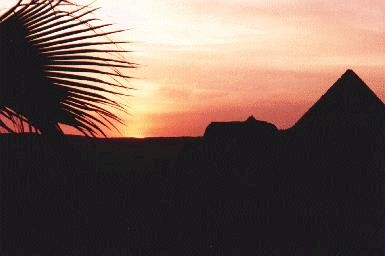

Guardian's Egypt
Late Breaking News
(All new articles are copyrighted by their respective sources)
Millenium Pyramid Celebration
By Siona Jenkins
EGYPT: Where will you be for New Year's Eve, 1999? If you haven't made plans yet, don't
despair: there's always the pyramids. While the rest of the world has been planning
millennium celebrations and fretting about possible Y2K computer glitches for the past two
years or more, the Egyptian authorities, confident in the drawing power of the world's
most famous monuments, have waited until the last minute to announce their own millennial
extravaganza; a12-hour spectacle at the Giza pyramids.
At sunset on December 31st, a gold-encased capstone will be lowered by helicopter onto the
top the Great Pyramid, setting off a specially commissioned dusk-to-dawn music and laser
show by the French musician Jean-Michel Jarre. "The opera will be called The Twelve
Dreams of the Sun," Jarre told a news conference here, adding that he had turned down
several other offers for the millennium for the "privilege" of performing at
Giza. "The pyramids are a reflection of mankind and eternity," he said by way of
explanation.
The idea for the celebration came from Pharaonic reliefs at Abu Sir, site of
yet more pyramids (albeit ruined ones)
about 15 km south of Giza. There Dr. Zahi Hawass, the ebullient archaeologist in charge of
the Giza Plateau,
discovered a scene depicting workers dragging a capstone with the hieroglyphic word for
"white gold" written
underneath. He also found a relief showing women dancing. "Every household in the
north and south of Egypt used to participate in the building of the pyramid by sending
workers, food and grain," explained Dr. Hawass. "My
interpretation is that when the king finished building the pyramid they put a capstone on
top and after that the people sang and danced because the nation's project was finished.
That is what we are doing at the millennium."
What the pyramids' ancient builders would have thought of the modern version of their own,
highly religious
celebration is impossible to guess. Perhaps they would approve of their god-king's tomb
being the centre of world
attention more than 5,000 years after it was built, even if the millennium party is
ultimately a secular event based on a calendar that is unrelated to their own. Or perhaps
they, like others in Egypt and around the world, would see
the show as yet another indignity visited on the ancient structures. For the pyramids have
suffered greatly over
the past century. As nationalist symbols of a glorious past and a money-spinning tourist
site they appear in logos
for everything from newspapers to plastic brushes, and have been used as a backdrop for
events ranging from squash tournaments to operas. No longer standing in awesome desert
isolation, they have been all but swallowed by the megalopolis that is modern Cairo. When
approached from the city, the immense stone structures are now obscured by shoddy
high-rises. On their northern side they are flanked by a highway and an enormous housing
development. A much-needed, but hotly-disputed ring-road is planned to hem them in only a
few kilometres to the south. Only when approached from the desert to the west, with the
city obscured in early morning haze, does the last remaining wonder of the ancient world
appear as it might have for most of its long history.
Unfortunately, even that impression is dispelled upon closer inspection. Tour
groups throng the basalt pavement
between the gigantic structures. As they move in large groups, shepherded by their guides,
camel and horse drivers jostle to grab their attention. Postcard sellers call out.
Individual tourists are continually harassed by aggressive would-be guides. On weekends
and national holidays, cheerfully raucous Egyptian families picnic in the area, adding to
the chaos. "The Giza Plateau is a zoo," Dr. Hawass admitted in a recent
interview. He has been engaged in a long-running battle to clean up the area but a
combination of bureaucratic inertia and the vested interests of the hundreds of touts that
swarm the area have combined to make it a Herculean task.
The millennium celebration has provided him with a much-needed deadline and by the time
New Year's Eve rolls
around he vows to have the infamous horse and camel drivers banished from beside the
pyramids to the desert beyond. Vehicles will be forbidden at the site and visitors who do
not want to walk will be ferried by electric carts.
How easy it will be to see all this on December 31st remains to be seen. Even before the
celebration was
announced travel agents around the world were using the pyramids as a selling point,
offering everything from
new-age meditation at their base to "Bedouin" picnics in the nearby desert. The
few hotel rooms still available
around Giza are going fast, although prices have yet to be set. Nobody yet knows how the
millennium spectacular will be organized, how many tickets will be available or how much
they will cost.
But Dr. Hawass is confident that Egypt's millennium party will be a success: "The
pyramids were built in the third
millennium BC and we are celebrating the third millennium AD and therefore this is
something that the whole world will watch."
Copyright IRISH TIMES
18-APR-99